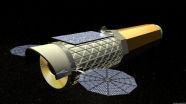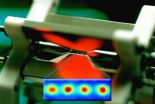(Press-News.org) It is to become the largest X-ray telescope ever: The International X-Ray Observatory (IXO), which has been planned in a cooperation between NASA, ESA and Japan's Aerospace Exploration Agency JAXA, will be launched into space in 2021 and provide the world with brand new information about black holes and, thus, about the origin of the universe. Its dimensions are gigantic: The surface of the mirror alone, which is to capture, for example, the cosmic X-radiation of black holes, will be 1300 m2 in size. It will consist of commercially available silicon wafers with pores of a few millimetres underneath. The quality of these "hidden" surfaces will be tested at the Physikalisch-Technische Bundesanstalt (PTB) with a monochromatic X-ray pencil beam. The new measuring device has been installed at PTB's synchrotron radiation laboratory at BESSY II in Berlin-Adlershof.
eROSITA will do the preliminary work. The German-Russian experiment under the auspices of the Max Planck Institute for Extraterrestrial Physics will be launched into space in 2013. With the aid of a bundle of seven X-ray telescopes, eROSITA will search the whole sky for a specific kind of black hole: supermassive black holes which developed at the dawn of the universe - probably even before the development of the first stars. Scientists expect that - among other things - approximately three million new black holes will be found with this mission. This will, for the first time, allow a complete overview of the formation and development of supermassive black holes to be given. IXO will then be responsible for their systematic investigation. In addition, the new space telescope is to provide much new information about neutron stars and stellar black holes, the second type of black hole which develops when especially massive stars explode. Due to the fact that such a venture is extremely expensive, in 2008 the space agencies of the USA, of Europe and Japan decided to realize this joint project from then on instead of three individual solutions.
IXO can capture the X-radiation of very distant black holes, because this kind of radiation penetrates - in an unhindered way - cosmic dust, which is the most frequently occurring impediment on the way. For that purpose, the mirror in the telescope must be very large, but at the same time light enough. IXO will have one single mirror with a collection surface of approx. 3 m², a focal length of 20 m and an angular resolution of less than 5 arc seconds. Due to the required grazing radiation incidence, the whole surface of the mirror must be approx. 1300 m². To construct this large surface in a stable and, at the same time, light way, the underneath of commercially available, highly polished silicon wafers will be provided with ribs to allow the wafers to be stacked in rigid blocks. Through this, pores with a cross-section of approximately 1 mm² are formed in which the radiation is reflected at the surface of the respective lower wafer. With respect to tangent errors and roughness, the quality of these "hidden" surfaces cannot be investigated as usual from above, but must be determined in the intended application geometry with X-ray reflection at grazing incident angles of approx. 1°. To investigate the reflecting surface of single pores, an X-ray pencil beam is required.
At the "X-ray pencil beam facility" (XPBF) at PTB's synchrotron radiation laboratory at BESSY II, which has recently been extended within the scope of a research cooperation with ESA, a monochromatic pencil beam with a typical diameter of 50 µm and a divergency of less than one arc second is now available for this purpose. It will characterize the X-ray lens systems for IXO at three different photon energies, i.e. at 1 keV, 2.8 keV and 7.6 keV. The lens systems can be adjusted or turned with a hexapod in vacuum with reproducibilities of 2 µm or below 1", respectively. The direct beam and the reflected beam are registered with a spatial resolving detector based on CCD at a distance of 5 m or 20 m from the lens system. For the last-mentioned distance, which corresponds to the intended focal length of IXO, a vertical movement of the CCD detector by more than 2 m has been implemented. First test measurements at this distance were already performed in May 2010, complete commissioning of the extended XPBF is planned for the beginning of November 2010.
INFORMATION:
Contact
Michael Krumrey, PTB Working Group 7.11 X-ray Radiometry,
phone: +49 (0)30 6392-5085,
E-mail: michael.krumrey@ptb.de
Current scientific publication
Krumrey, M.; Cibik, L.; Müller, P.; Bavdaz, M.; Wille, E.; Ackermann, M.; Collon, M. J.: X-ray pencil beam facility for optics characterization. Proc. SPIE 7732, 77324O (2010)
Gigantic mirror for X-radiation in outer space
New PTB instrument measures the quality of the mirrors for the X-ray telescope IXO
2010-09-28
ELSE PRESS RELEASES FROM THIS DATE:
A study analyzes consumer protection laws in Spain
2010-09-28
The idea behind this research arose because of the huge disparity in existing laws regulating the area of consumer protection, which made it necessary, according to the researchers, to carry out a systematic study to develop a "general report" which would gather the common principles and regulations regarding the different laws governing consumer protection. During the time this research study was underway, the Texto Refundido de la Ley General para la Defensa de los Consumidores y Usuarios (Consolidated Text of General Law of Consumer Protection) (LGDCU) was published; ...
Quantum physics: Flavors of entanglement
2010-09-28
Entanglement is a fascinating property connecting quantum systems. Albert Einstein called it the "spooky action at a distance". This bizarre coupling can link particles, even if they are located on opposite sides of the galaxy. The strength of their connections is behind the promising quantum computers, the dream machines capable of quick and efficient computations.
The team lead by Rainer Blatt at the Institute of Experimental Physics of the University of Innsbruck has been working very successfully towards the realization of a quantum computer. In their recent study, ...
Medical profession needs special training to handle self-harm, says international review
2010-09-28
Healthcare professionals are still not receiving the appropriate training and support they need to help people who self-harm and this can result in negative attitudes and inadequate levels of care.
Those are the key findings of a research review carried out by mental health specialists from the University of Nottingham, UK, and published in the October issue of the Journal of Psychiatric and Mental Health Nursing.
Staff nurse Jo McHale and lecturer Anne Felton studied 19 papers from the UK, Australia, Sweden and Ireland, dating from 1998 to 2009 and covering the views ...
Spaniards choose stable jobs over ones related to their training
2010-09-28
"If you study, you are more likely to get a stable job, even if it doesn't have anything to do with your training". This is the thinking of workers living in Spain, according to a research study by the Pompeu Fabra University (UPF), which studied the level of over-education in Spain, Italy and France, and the relationship between this and temporary work.
"This can be explained by the high levels of employment insecurity in Spain in comparison with other European countries", Luis Ortiz, author of the study and a researcher at the UPF, tells SINC.
The study, which has ...
Novel mechanism discovered for communication between proteins that cause 'cell suicide'
2010-09-28
A recent study undertaken by investigators at five research centres, amongst which is the CSIC-University of the Basque Country Biophysics Unit, provides new clues for the understanding of the 'cell suicide' process. The research was published in the latest issue of the prestigious Cell journal.
Our bodies daily eliminate in a controlled manner more than 100 million defective cells, by means of a procedure known as 'cell suicide' or apoptosis. This is a highly complicated process, any imbalances thus arising causing serious diseases, prominent amongst which is cancer. ...
Red light regulates nectar secretion
2010-09-28
Flowering plants produce nectar to attract insect pollinators. Some plant species, such as Lima bean, also secrete nectar from so-called extrafloral nectaries to attract ants which in turn fend off herbivores. Scientists of the Max Planck Institute in Jena, Germany, have discovered that the production of extrafloral nectar is light dependent. They have shown that the plants are able not only to distinguish between day and night, but also to adapt their nectar secretion to current light conditions by using a special photoreceptor, the phytochrome. Phytochrome probably influences ...
Surgery found effective for patients with aggressive prostate cancer
2010-09-28
ROCHESTER, Minn. -- In one of the first studies to focus exclusively on the outcomes after treatment for patients with high-risk prostate cancer,(http://www.mayoclinic.org/prostate-cancer/) researchers have found that surgery provides high survival rates. Collaborating researchers at Mayo Clinic and Fox Chase Cancer Center (http://www.fccc.edu/) in Philadelphia discovered that patients with the most aggressive forms of prostate cancer who had radical prostatectomy procedures had a 10-year cancer-specific survival rate of 92 percent and an overall survival rate of 77 percent.
The ...
Computer model shows US vulnerable to MDR-TB epidemic
2010-09-28
While the U.S. has made great progress in the prevention and treatment of tuberculosis, the nation has become more susceptible to potential epidemics of multidrug-resistant tuberculosis (MDR-TB), according a study led by Johns Hopkins researchers. Computer simulations show that as TB prevalence falls, the risk for more extensive MDR-TB increases. In addition, the simulation also showed that higher detection of TB cases without proper treatment of cases also increased risk. The study findings are published in the September 22 edition of the journal PLoS ONE. An interactive ...
Study shows patient-specific vaccines for metastatic melanoma may induce durable complete regression
2010-09-28
Newport Beach, CA – September 27, 2010 – Hoag Memorial Hospital Presbyterian recently announced encouraging clinical study results for patient-specific vaccine therapy to treat metastatic melanoma. The study is ongoing, but the report concludes that patient-specific vaccines can sometimes induce durable complete regression of progressing soft-tissue melanoma metastases, as demonstrated in one particular patient who participated in the trial.
The study report, entitled: "Durable Complete Response of Refractory, Progressing, Metastatic Melanoma after Treatment with a ...
Diving deeper into the gene pool
2010-09-28
About ten years ago, the discovery of microRNAs ― tiny cellular molecules that regulate our genetic code ― unlocked a world of scientific possibilities, including a deeper understanding of human disease. One new analytical technology is "deep sequencing," which gives scientists the ability to discover invaluable information about human diseases at a genetic level. Now, Tel Aviv University researchers have developed the cutting-edge technology to better analyze these results.
The software, called miRNAkey, was developed by Roy Ronen as part of a team of researchers ...
LAST 30 PRESS RELEASES:
Research on the behavioral mechanisms of rural distributed photovoltaic development: A view of prosumer perspective
More surgical patients are on opioid use disorder medications — hospitals must modernize pain care
New study reveals strategic logic behind global patent litigation venue selection
An abnormally slow heart rate is associated with xylazine-fentanyl overdose; primarily seen in northeastern United States
The path to solar weather forecasts
Inflammation and mitochondrial dysfunction in cirrhotic cardiomyopathy: therapeutic implications
The Great Bear Rainforest nature writing retreat
Research reveals hidden diversity of E. coli driving diabetic foot infections
Breakthrough in parallel Cartesian grid generation: Dynamic partition weight strategy resolves load imbalance
ESMT Berlin study shows how startups can communicate to win over silent audiences online
Design and optimization of wide-speed double swept waverider based on curved-cone projection method
Giant Magellan Telescope names Daniel T. Jaffe as president
New parameterization method for cislunar space cataloging enhances orbital awareness in Earth-Moon system
A “nu” way to measure researcher impact
Dark matter may have begun much hotter than scientists thought
Board games boost young kids’ math skills, UO research review shows
Unleashing floods: Researchers learn more about how fossils form
An open-source robotic system to perform cell culture tasks
Fathers’ health influences offspring through sperm RNAs
Korea University study mimics heart mechanics in organoids using three-dimensional magnetic torque
Catching a radical in motion with µSR spectroscopy
Hanbat National University researchers reveal smart transparent woods that block UV and save energy
Rhythm contains important information for the cell
Nitrogen is key to faster regrowth in deforested areas, say researchers
Recovering tropical forests grow back nearly twice as fast with nitrogen
A new diet option for mild-to-moderate Crohn’s disease
Electric vehicles could catch on in Africa sooner than expected
New test could help pinpoint IBD diagnosis, study finds
Common eye ointment can damage glaucoma implants, study warns
ACCESS-AD: a new European initiative to accelerate timely and equitable AD diagnosis, treatment and care
[Press-News.org] Gigantic mirror for X-radiation in outer spaceNew PTB instrument measures the quality of the mirrors for the X-ray telescope IXO



